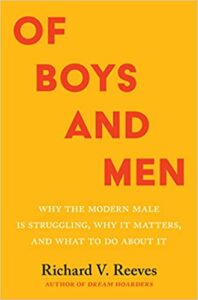The Boys Under the Bus
By Arnold Kling


- … the problems of boys and men are structural in nature… the educational system is structured in ways that put them at a disadvantage. Men are struggling in the labor market because of an economic shift away from traditionally male jobs. And fathers are dislocated because the cultural role of family provider has been hollowed out.
- —Richard V. Reeves, Of Boys and Men,1 p. 10
- In 1979, the weekly earnings of the typical American man who completed his education with a high school diploma, was, in today’s dollars, $1,017. Today it is 14% lower at $881. (p. 10)
- One in three men with only a high school education are now out of the labor force. (p. 35)
- One in four Black men born since the late 1970s have been in prison by their mid-30s. Among those who dropped out of high school, it is seven out of ten. (p.75)
- Deaths of despair are almost three times higher among men than women (p. 83)
One of Reeves’ most interesting observations is that anti-poverty interventions that succeed often only work for women, not men. For example, some well-known experimental preschool programs, “Showed “substantial” long-term benefits for girls, but “no significant long-term benefits for boys.” (p. 102)
Reeves reports similar results for other educational interventions. As for labor market interventions, Reeves notes that in an experimental wage subsidy program, “A rigorous evaluation of the pilot by the MDRC research group found ‘a relatively large positive effect on employment rates among women,’ but ‘no detectable effect among men’.” (p. 104)
I wonder if the list of interventions that worked spectacularly for women and less well for men should include expanded access to higher education, stimulated by federal loans and grants. Perhaps one can interpret the statistics on the high prevalence of females in college relative to 50 years ago in this way. The number of men attending college may have stayed the same, or even risen, but the push to increase college enrollment has exerted a far stronger influence on women.
Reeves emphasizes that men with high levels of educational attainment are doing well in absolute terms, and in some high-status realms women are still in the process of catching up. The problems seem to be concentrated among less-educated men.
Looking abroad, Reeves says:
- Finland’s internationally acclaimed educational performance is entirely explained by the stunning performance of Finnish girls. (In fact, American boys do just as well as Finnish boys do on the PISA reading test.) (p. 17)
In short, we are faced with these questions:
- 1. Why are men faring so poorly?
- 2. Why are the problems concentrated among lesser-educated men?
- 3. Why have these problems arisen in recent decades, and not earlier?
- 4. Why do we observe similar trends in other countries, not just the United States?
One diagnosis that Reeves highlights is the fact that boys mature more slowly than girls, particularly during adolescence. He emphatically argues for starting boys in school a year later than girls.
But this diagnosis cannot answer questions (2) and (3). If slow maturation of boys is the problem, then the impact should be felt across the class spectrum. And the problem for boys should have been apparent long ago, not just coming to light recently.
Moreover, Reeves only cites one study demonstrating the benefits of delayed school entry for boys. I do not find that compelling, given the poor replication track record of other promising educational interventions. One would think that there would be many studies available, given that birthday cutoffs provide a “natural experiment” that could be mined for analysis.
Reeves’ list of causal factors for the plight of lesser-educated males includes changes in job structures: “The long-run shift away from jobs requiring physical strength is going to continue. Fewer than one in ten jobs now require what the Bureau of Labor Statistics describes as ‘heavy work’.” (p. 38)
Reeves sees the political left as overly focused on segments of society where women still have not caught up to men. Male earnings advantages exist at the top end of the income scale. But the left obsesses with these disparities while ignoring the lesser-educated half of the population, where the problems that males are having is what stands out.
Reeves sees the political right as living with the hope of a return to the traditional household with the male as the primary breadwinner. But, he says:
- This analysis is wrong. Feminism has upended patriarchy, a specific social order that had the fatal flaw of being grossly unequal… we can help men without hindering women or trying to turn back the clock. (p. 160)
Reeves does not address one strand of conservative thought, which is the effect of broken households on young males. Instead, Reeves discusses absent fathers as a symptom of the male crisis. That is, a low proportion of lesser-educated men are married to the mother of their children. But other commentators see the absence of fathers as a causal factor. In this view, not having a father in the home harms boys as they grow up.
One structural factor that Reeves does not discuss is the way that the state has come to replace the father in a household. For a single mother, means-tested benefits, such as Medicaid and food stamps, reduce the incentive to get married in two ways. First, they make it easier for the woman to get by without an additional income. Second, and more insidiously, they tax away as much as 80 percent of any additional income.2 Whatever wages a blue-collar husband brings home are mostly offset by lost benefits. If we redesigned welfare policy so that a low-income married couple instead could keep most of what they earn, perhaps marriage would be a more attractive option.
Reeves’ second major policy recommendation is to train men to work in the service sector:
- The share of men in HEAL occupations—health, education, administration, and literacy—remains stubbornly low… More men can certainly do HEAL jobs. And given the trends in the labor market, they must. (p. 184)
To me, this seems easier said than done. Women have successfully moved into positions in law, medicine, higher education, and management. But those are positions that reward the effort one must make to enter those fields. Becoming a home health care aide is never going to be as aspirational for a man as becoming a bank executive might be for a woman. Meanwhile, the HEAL jobs that command respect and a decent income, such as nurse or teacher, are beyond the reach of lesser-educated males.
Reeves’ third major policy recommendation is to reform work-related practices and laws to enable fathers to devote more time to childcare. He also wants to help formalize arrangements for unmarried fathers:
- In every U.S. State, an unmarried mother is the presumed sole custodial parent. Unmarried fathers must first prove paternity (in married couples this is assumed), and then petition for visitation and custody. For many fathers this can prove a difficult process. In the meantime, the mother can choose to bar all access…
- … Married fathers are seen as three-dimensional beings. Unmarried fathers are seen as walking ATMs…
- … The long run goal ought to be to integrate child support decisions for unmarried parents into the legal process for determining custody and visitation arrangements. (p. 215-216)
For more on these topics, see
- Gender Gap, by Claudia Goldin. Concise Encyclopedia of Economics.
 Roy Baumeister on Gender Differences and Culture. EconTalk.
Roy Baumeister on Gender Differences and Culture. EconTalk. Alison Wolf on Women, Inequality and the XX Factor. EconTalk.
Alison Wolf on Women, Inequality and the XX Factor. EconTalk.
A conservative probably would say that the long run goal ought to be to support decisions to get married in order to raise children.
Of Boys and Men is an excellent book for stimulating a conversation about the plight of less-educated males. Reeves makes every effort to ensure that this conversation need not threaten the progress of well-educated females. I hope that feminists can appreciate that.
Footnotes
[1] Richard V. Reeves, Of Boys and Men: Why the Modern Male Is Struggling, Why It Matters, and What to Do about It. September 27, 2022.
[2] See the analysis by John Early, “Reassessing the Facts about Inequality, Poverty, and Redistribution,” who finds that “the middle-income group averages only 20 percent more spendable income than that of the lowest group. Government income redistribution basically flattens out the bottom 60 percent of income to within 20 percent of each other.” Cato Institute, April 2018. PDF file.
*Arnold Kling has a Ph.D. in economics from the Massachusetts Institute of Technology. He is the author of several books, including Crisis of Abundance: Rethinking How We Pay for Health Care; Invisible Wealth: The Hidden Story of How Markets Work; Unchecked and Unbalanced: How the Discrepancy Between Knowledge and Power Caused the Financial Crisis and Threatens Democracy; and Specialization and Trade: A Re-introduction to Economics. He contributed to EconLog from January 2003 through August 2012.
Read more of what Arnold Kling’s been reading. For more book reviews and articles by Arnold Kling, see the Archive.
